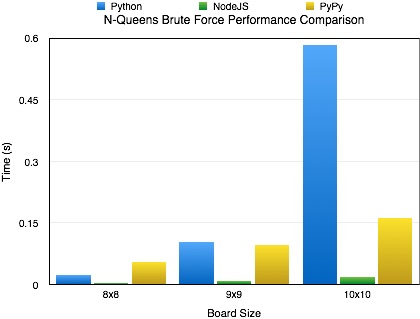

Some History
This is a followup to my original post: Node.js vs Python vs PyPy – A Simple Performance Comparison. This article corrects a discrepancy caused by a slight difference in the JavaScript implementation which skewed the Node.js results.
The Algorithm
As stated in the previous article, I’ve attempted to implement the same single-thread, brute force, recursive algorithm in many different languages. There is nothing overly special about this algorithm and I’ve made no attempts to optimize it.
The Findings
Node is fast, very fast. It easily outperforms any of the other implementations I’ve included in the puzzle’s repository. As you can see by the included charts, the performance difference between Node.js and out-of-the-box Python is very significant and the difference between it and PyPy while less pronounced is significant.
Special Notes
- I’ve placed my source on GitHub at the following url: https://github.com/chaddotson/puzzles. It now contains functional N-Queens puzzle implementations in JavaScript, Python, Lua, Scala, and Ruby. There is also a version in Rust, but that needs to be updated to the latest syntax before it can be run again.
- This is just with one type of algorithm, the best solution might and probably does change depending on what type of application you are researching. For webserver performance, Node.js is slightly better than PyPy running Tornado.
- This algorithm is a simple brute force algorithm, there are many faster and better ones out there.
- See the original article for the Node.js vs Python vs PyPy – A Simple Performance Comparison for more details memory performance.

Node.js vs Python vs PyPy – A Simple Performance Comparison – Updated http://t.co/AF2ui2OVNN
RT @Arcaneous: Node.js vs Python vs PyPy – A Simple Performance Comparison – Updated http://t.co/AF2ui2OVNN
Pingback: Node.js vs Python vs PyPy – A Simple Performance Comparison | Chad Dotson
Awesome post! Just one question: would you happen to remember what hardware you were using when you ran these?
macOS 2.4ghz i7, 16gb.